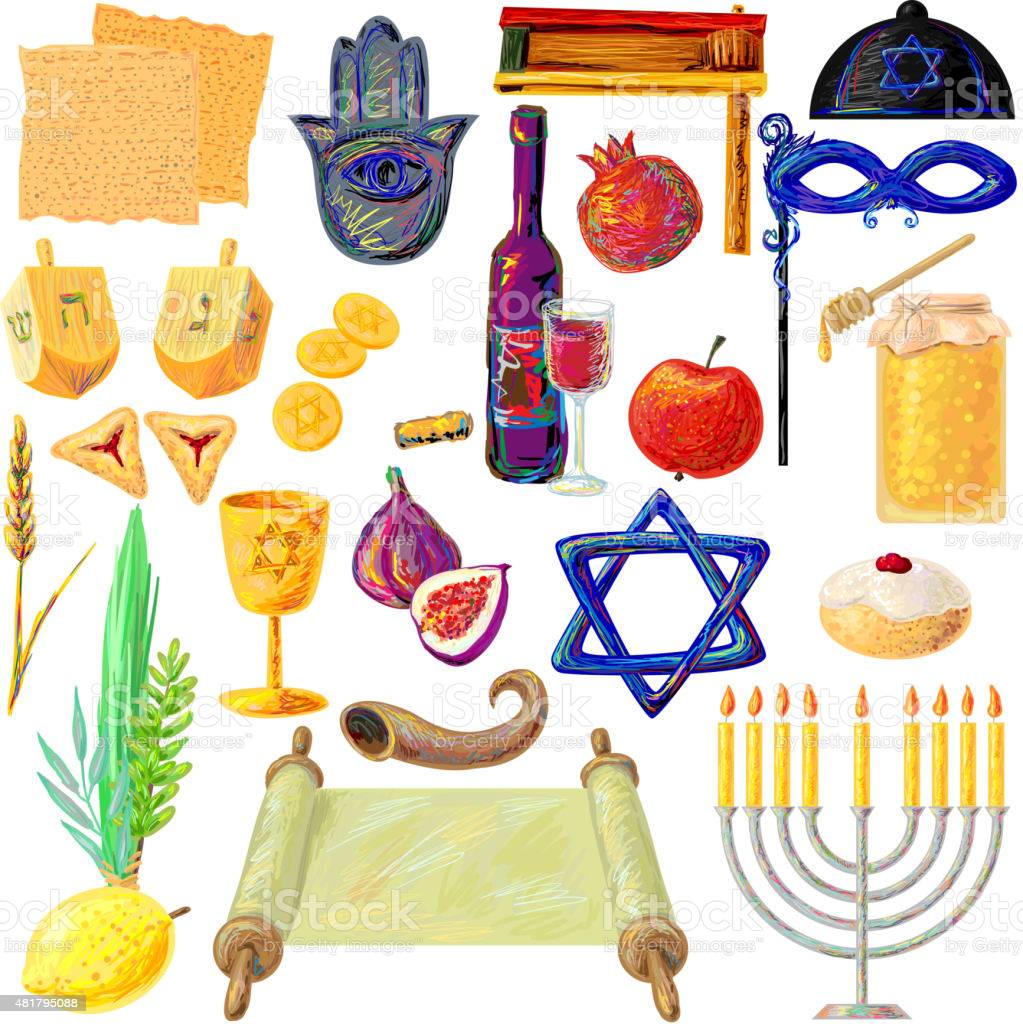"Yerushalayim Shel Zahav" "on one foot":
In 1967, Naomi Shemer wrote the song "Yerushalayim Shel Zahav", "Jerusalem of Gold". It has become associated with the holiday "Yom Yerushalayim". This source sheet looks at the verses of the song in detail.

“Yerushalayim Shel Zahav”, by Shira, age 5 (2021)
Naomi Shemer describing the writing of Yerushalayim Shel Zahav:
"In the winter of '67 I was approached by Gil Aldema of The Voice of Israel. Teddy Kollek (the mayor at the time) had asked him to commission a song about Jerusalem. For many years, the Voice of Israel held a song competition on Independence Day, until then broadcast on the radio only (because we only got television in 1968). That same year, 1967, they elected, on a one-time basis to also commission songs from five professional composers, I among them. I found it very difficult to write the song, until I recalled the legend about Rabbi Akiva promising his wife Rachel a "city of gold," i.e. a piece of gold jewelry depicting Jerusalem. I chose Shuli Nathan to perform the song. She was a 20-year old soldier-teacher, with a guitar and a voice like bells. The song was a hit from the very first performance and, at midnight, when Shuli was asked to return to the stage, the audience was already singing along on the chorus... "
History of the Song (Wikipedia)
Naomi Shemer wrote the original song for the Israeli Song Festival (it was not in competition but had been commissioned by the Mayor of Jerusalem, Teddy Kollek), held on 15 May 1967, the night after Israel's nineteenth Independence Day. She chose the then-unknown Shuli Nathan to sing the song.[1][2]
Some of the song's melody is based on a Basque lullaby, Pello Joxepe[3][4] (Pello is a typical basque name, but it can also mean Foolish Joseph[dubious – discuss]), composed by Juan Francisco Petriarena 'Xenpelar' (1835–1869).[citation needed] Shemer heard a rendition by singer/songwriter Paco Ibáñez, who visited Israel in 1962 and performed the song to a group that included Shemer[4] and Nehama Hendel.[citation needed] She later acknowledged hearing Hendel perform Pello Joxepe in the mid-1960s, and that she had unconsciously based some of the melody on the lullaby.[citation needed] Shemer felt very bad about the similararity of her song to Pello Joxepe, but when Ibáñez was asked how he felt about the issue, he replied he was "glad it helped in some way", and that he was not angry, nor did he perceive it as plagiarism.[4]
At that time, the Old City was still controlled by the Hashemite Kingdom of Jordan and under its occupying rule. Jews had been banned from the Old City and the rest of East Jerusalem, losing their homes and possessions and becoming refugees. All Jews were barred from either returning or entering the areas under Jordanian control, and many holy sites were desecrated and damaged during that period.[5] Only three weeks after the song was published, the Six-Day War broke out, and the song became a morale-boosting battle anthem of the Israel Defense Forces. Shemer herself sang it for the troops before the war and the festival, making them among the first in the world to hear it.
On 7 June 1967, the IDF wrested eastern Jerusalem and the Old City from the Jordanians. Shemer was about to perform for a troop of paratroopers (who were not engaged in combat at the moment) when she heard that the Western Wall and Temple Mount were “in our hands” (the Israeli army). Instead of simply announcing this to the troop, she quickly penned a new verse which modified the second verse. Instead of “Alas . . . the [Old City] shuk is empty and we cannot visit the Temple Mount,” she wrote: “We have returned to . . . the shuk; the shofar is sounding at the Temple Mount. . .” — thereby informing the paratroopers through the song, that Israel had captured the Western Wall and Temple Mount. The line about the shofar sounding from the Temple Mount is a reference to army chaplain Rabbi Shlomo Goren’s sounding the shofar immediately after capture of the Western Wall. Shemer later stated that she did not intend for this new verse to replace the second verse, and that the original three verses should remain the official song.[6]
https://en.wikipedia.org/wiki/Jerusalem_of_Gold
אֲוִיר הָרִים צָלוּל כַּיַּיִן
וְרֵיחַ אֳרָנִים
נִשָּׂא בְּרוּחַ הָעַרְבַּיִם
עִם קוֹל פַּעֲמוֹנִים,
וּבְתַרְדֵּמַת אִילָן וָאֶבֶן
שְׁבוּיָה בַּחֲלוֹמָהּ,
הָעִיר אֲשֶׁר בָּדָד יוֹשֶׁבֶת
וּבְלִבָּהּ חוֹמָה.
יְרוּשָׁלַיִם שֶׁל זָהָב וְשֶׁל נְחֹשֶׁת וְשֶׁל אוֹר,
הֲלֹא לְכָל שִׁירַיִךְ אֲנִי כִּנּוֹר.
אֵיכָה יָבְשׁוּ בּוֹרוֹת הַמַּיִם
כִּכַּר הַשּׁוּק רֵיקָה,
וְאֵין פּוֹקֵד אֶת הַר הַבַּיִת
בָּעִיר הָעַתִּיקָה,
וּבַמְּעָרוֹת אֲשֶׁר בַּסֶּלַע
מְיַלְּלוֹת רוּחוֹת,
וְאֵין יוֹרֵד אֶל יַם הַמֶּלַח
בְּדֶרֶךְ יְרִיחוֹ
יְרוּשָׁלַיִם שֶׁל זָהָב...
חָזַרְנוּ אֶל בּוֹרוֹת הַמַּיִם
לַשּׁוּק וְלַכִּכָּר,
שׁוֹפָר קוֹרֵא בְּהַר הַבַּיִת
בָּעִיר הָעַתִּיקָה,
וּבַמְּעָרוֹת אֲשֶׁר בַּסֶּלַע
אַלְפֵי שְׁמָשׁוֹת זוֹרְחוֹת,
נָשׁוּב נֵרֵד אֶל יָם הַמֶּלַח
בְּדֶרֶךְ יְרִיחוֹ.
יְרוּשָׁלַיִם שֶׁל זָהָב...
The mountain air is clear as wine
.
And the scent of pines
Is carried on the breeze of twilight
With the sound of bells.
And in the slumber of tree and stone
Captured in her dream
The city that sits solitary
And in its midst is a wall.
Chorus:
Jerusalem of gold
And of bronze, and of light
Behold I am a violin for all your songs.x2
How the cisterns have dried
The market-place is empty
And no one frequents the Temple Mount
In the Old City.
And in the caves in the mountain
Winds are howling
And no one descends to the Dead Sea
By way of Jericho.
Chorus:
But as I come to sing to you today,
And to adorn crowns to you (i.e. to tell your praise)
I am the smallest of the youngest of your children (i.e. the least worthy of doing so)
And of the last poet (i.e. of all the poets born).
For your name scorches the lips
Like the kiss of a seraph
If I forget thee, Jerusalem (Psalm 137)
Which is all gold...
Chorus:
We have returned to the cisterns
To the market and to the market-place
A ram's horn calls out on the Temple Mount
In the Old City.
And in the caves in the mountain
Thousands of suns shine -
We will once again descend to the Dead Sea
By way of Jericho!
Chorus
What sources inspired Naomi Shemer's song?
The First Verse
אֲוִיר הָרִים צָלוּל כַּיַּיִן וְרֵיחַ אֳרָנִים נִשָּׂא בְּרוּחַ הָעַרְבַּיִם עִם קוֹל פַּעֲמוֹנִים
וּבְתַרְדֵּמַת אִילָן וַאֶבֶן שְׁבוּיָה בַּחֲלוֹמָהּהָעִיר אֲשֶׁר בָּדָד יוֹשֶׁבֶת וּבְלִבָּהּ חוֹמָה.
טעם ריח מישוש שמיעה
The mountain air is clear as wine
And the scent of pines
Is carried on the breeze of twilight
With the sound of bells.
And in the slumber of tree and stone
Captured in her dream
The city that sits solitary
And in its midst is a wall.
How many senses are in this verse?
(א) אֵיכָ֣ה ׀ יָשְׁבָ֣ה בָדָ֗ד הָעִיר֙ רַבָּ֣תִי עָ֔ם הָיְתָ֖ה כְּאַלְמָנָ֑ה רַּבָּ֣תִי בַגּוֹיִ֗ם שָׂרָ֙תִי֙ בַּמְּדִינ֔וֹת הָיְתָ֖ה לָמַֽס׃ (ס)
(1) Alas! Lonely sits the city once great with people! She that was great among nations is become like a widow; the princess among states is become a thrall.
Context: This is from the beginning of the Biblical Book of Lamentations ("Eicha", in Hebrew). Lamentations describes Jerusalem after the loss of Jewish sovereignty over the entirety of the city.
Given the timing of when this verse was written, why might Naomi Shemer have wanted to invoke Lamentations?
אָמַר רַבִּי יוֹחָנָן כׇּל יָמָיו שֶׁל אוֹתוֹ צַדִּיק הָיָה מִצְטַעֵר עַל מִקְרָא זֶה שִׁיר הַמַּעֲלוֹת בְּשׁוּב יהוה אֶת שִׁיבַת צִיּוֹן הָיִינוּ כְּחֹלְמִים אָמַר מִי אִיכָּא דְּנָיֵים שִׁבְעִין שְׁנִין בְּחֶלְמָא יוֹמָא חַד הֲוָה אָזֵל בְּאוֹרְחָא חַזְיֵיהּ לְהָהוּא גַּבְרָא דַּהֲוָה נָטַע חָרוּבָא אֲמַר לֵיהּ הַאי עַד כַּמָּה שְׁנִין טָעֵין אֲמַר לֵיהּ עַד שִׁבְעִין שְׁנִין אֲמַר לֵיהּ פְּשִׁיטָא לָךְ דְּחָיֵית שִׁבְעִין שְׁנִין אֲמַר לֵיהּ הַאי גַּבְרָא עָלְמָא בְּחָרוּבָא אַשְׁכַּחְתֵּיהּ כִּי הֵיכִי דִּשְׁתַלוּ לִי אֲבָהָתִי שְׁתַלִי נָמֵי לִבְרָאִי יָתֵיב קָא כָּרֵיךְ רִיפְתָּא אֲתַאי לֵיהּ שִׁינְתָּא נִים אַהְדַּרָא לֵיהּ מְשּׁוּנִּיתָא אִיכַּסִּי מֵעֵינָא וְנִים שִׁבְעִין שְׁנִין כִּי קָם חַזְיֵיהּ לְהָהוּא גַּבְרָא דְּהוּא קָא מְלַקֵּט מִינַּיְיהוּ אָמַר לֵיהּ אַתְּ הוּא דִּשְׁתַלְתֵּיהּ אֲמַר לֵיהּ בַּר בְּרֵיהּ אֲנָא אֲמַר לֵיהּ שְׁמַע מִינַּהּ דִּנְיַימִי שִׁבְעִין שְׁנִין חֲזָא לַחֲמָרְ[תֵּ]יהּ דְּאִתְיְילִידָא לַיהּ רַמְכֵי רַמְכֵי
§ The Gemara relates another story about Ḥoni HaMe’aggel. Rabbi Yoḥanan said: All the days of the life of that righteous man, Ḥoni, he was distressed over the meaning of this verse: “A song of Ascents: When the Lord brought back those who returned to Zion, we were like those who dream” (Psalms 126:1). He said to himself: Is there really a person who can sleep and dream for seventy years? How is it possible to compare the seventy-year exile in Babylonia to a dream? One day, he was walking along the road when he saw a certain man planting a carob tree. Ḥoni said to him: This tree, after how many years will it bear fruit? The man said to him: It will not produce fruit until seventy years have passed. Ḥoni said to him: Is it obvious to you that you will live seventy years, that you expect to benefit from this tree? He said to him: That man himself found a world full of carob trees. Just as my ancestors planted for me, I too am planting for my descendants. Ḥoni sat and ate bread. Sleep overcame him and he slept. A cliff formed around him, and he disappeared from sight and slept for seventy years. When he awoke, he saw a certain man gathering carobs from that tree. Ḥoni said to him: Are you the one who planted this tree? The man said to him: I am his son’s son. Ḥoni said to him: I can learn from this that I have slept for seventy years, and indeed he saw that his donkey had sired several herds during those many years.
Context: This is from the Babylonian Talmud, Tractate Ta'anit, which is about fast days. There would be fast days declared when there hadn't been rain in a long time, and Honi haMe'ageil (Honi the Circle Maker) was known for drawing a circle around himself and telling G-d that he wasn't leaving the circle until G-d brought rain. This is another story about Honi, tying a stone cliff and a tree to the idea of returning to Zion/Jerusalem as if it were a dream (or as if we had just been dreaming our absence).
Why would Naomi Shemer have wanted to invoke this story in a song about Jerusalem?
The Chorus
יְרוּשָׁלַיִם שֶׁל זָהָב וְשֶׁל נְחֹשֶׁת וְשֶׁל אוֹר הֲלֹא לְכָל שִׁירַיִךְ אֲנִי כִּנּוֹר.
Jerusalem of gold, of bronze and of light
Behold I am a harp for all of your songs.
אור חָדָשׁ עַל צִיּון תָּאִיר וְנִזְכֶּה כֻלָּנוּ מְהֵרָה לְאורו.
Cause a new light to shine upon Zion, and may we all be worthy soon to enjoy its brightness.
Context: This is the prayer “Or Chadash”, which is found before the Shema in the morning service on both weekdays and Shabbat/Festivals. When it refers to Zion, that usually means Jerusalem, also sometimes also it means the Land of Israel. The prayer is asking G-d to shine a new light on Jerusalem.
What does this image add to the song?
רַבִּי עֲקִיבָא אִיתְקַדַּשַׁת לֵיהּ בְּרַתֵּיה (דְּבַר) דְּכַלְבָּא שָׂבוּעַ שְׁמַע (בַּר) כַּלְבָּא שָׂבוּעַ אַדְּרַהּ הֲנָאָה מִכׇּל נִכְסֵיהּ אֲזַלָא וְאִיתְנְסִיבָה לֵיהּ בְּסִיתְוָא הֲוָה גָּנוּ בֵּי תִיבְנָא הֲוָה קָא מְנַקֵּיט לַיהּ תִּיבְנָא מִן מַזְּיַיהּ אֲמַר לַהּ אִי הֲוַאי לִי רָמֵינָא לִיךְ יְרוּשָׁלַיִם דְּדַהֲבָא
Rabbi Akiva became betrothed to the daughter of Kalba Savua. When Kalba Savua heard about their betrothal, he took a vow prohibiting her from eating from his property. Despite this, she went ahead and married him. In the winter they would sleep in a storehouse of straw, and he [Rabbi Akiva] would gather strands of straw from her hair. He said to her: If I had the means I would present you with a Jerusalem of Gold.
Context: This is from the Babylonian Talmud, Masechet (Tractate) Nedarim, which is about vows. You might think that this story is in this tractate because Rabbi Akiba’s wife is disinherited by her father via a vow, and later when Akiba becomes a great rabbi his father-in-law seeks a dissolution of the vow, but that is not how the Gemara arrives at this story. Rather, it is commenting on a mishnah about taking vows to not eat certain foods. This leads to a discussion of eating and how various rabbis behaved while eating. The last rabbi talked about is Rabbi Judah bar Illai. The Gemara then relates several more stories about him, including how he miraculously received some money. This leads to Rabbi Akiba, and how he got money from his father-in-law in the end.
Note that in this story a “Jerusalem of Gold” is a crown of gold in the shape of Jerusalem's walls. According to other Rabbinic texts (Avot d'Rabbi Natan 6:2, Shabbat 59a:9), Rabbi Akiva was eventually able to buy his wife this tiara.
Why might this story be so integral to the song that it gives the title of the song?
British Military Government Official Communique No. 34, 1918
No person shall demolish, erect, alter, or repair the structure of any building in the City of Jerusalem or its environs within a radius of 2500 metres from the Damascus Gate (Bab-al-Amud) until he has obtained a written permit from the Military Governor.
Plaster and corrugated iron sheeting are forbidden as building material. All construction must use native Jerusalem stone in order to respect the tradition of stone vaulting, the heritage in Jerusalem of an immemorial and hallowed past.
Any person contravening the orders contained in this proclamation, or any term or terms contained in a license issued to him under this proclamation will be liable upon conviction to a fine not exceeding 200 English pounds.
R. Storrs
Colonel
Military Governor
Jerusalem, 8th April 1918
Context: General Allenby of Great Britain conquered Jerusalem from the Ottoman Empire on Erev Chanukah, December 9, 1917. Shortly thereafter, Colonel Ronald Storrs was appointed the military governor of the city. He brought William McLean, the city engineer of Alexandria (Egypt) to come up with an urban planning guide for development in Jerusalem. One of the regulations that they put in place was that all new buildings in Jerusalem had to be built out of Jerusalem stone. When the sunlight hits these buildings, the city appears to be made of gold.
What layer of meaning does this fact add to the song?
(Proclamation found in R. Storrs, Preface to C.R. Ashbee Jerusalem: 1918-1920, the Records of the Pro-Jerusalem Council (London, 1921), cf. n. 2, p. V; cited in Sapir, Shaul. Historical Geography of Jerusalem Through the Ages, The Hebrew University of Jerusalem School for Overseas Students, Jerusalem, 1996)
ציון הלא תשאלי / רבי יהודה הלוי
צִיּוֹן, הֲלֹא תִשְׁאֲלִי לִשְׁלוֹם אֲסִירַיִךְ,
דּוֹרְשֵׁי שְׁלוֹמֵךְ וְהֵם יֶתֶר עֲדָרָיִךְ?
מִיָּם וּמִזְרָח וּמִצָּפוֹן וְתֵימָן שְׁלוֹם
רָחוֹק וְקָרוֹב שְׂאִי מִכֹּל עֲבָרָיִךְ,
וּשְׁלוֹם אֲסִיר תַּאֲוָה, נוֹתֵן דְּמָעָיו כְּטַל–
חֶרְמוֹן וְנִכְסַף לְרִדְתָּם עַל הֲרָרָיִךְ!
לִבְכּוֹת עֱנוּתֵךְ אֲנִי תַנִּים, וְעֵת אֶחֱלֹם
שִׁיבַת שְׁבוּתֵך – אֲנִי כִנּוֹר לְשִׁירָיִךְ.
Rabbi Yehuda Halevi
Zion, behold, will you not ask after the welfare of your prisoners,
Who seek your welfare, and are the remnant of your flock?
From west and east, and from north and south,
The welfare of those far and near, inquire from all of your sides.
And the welfare of the prisoner of hope, who sheds tears like Hermon’s dew,
And yearns for them to descend upon your mountains.
Crying for your suffering, I am a jackal,
And when I dream of the return of your captives, I am a harp for your songs.
Context: This is the first verse of one of the poems about Zion written by Yehudah haLevi, a medieval Jewish poet from Spain (1075-1141). He moved to Jerusalem at the end of his life, after having written poems such as “My heart is in the East / While I am in the West”.
You can find the full poem here: https://rechovot.blogspot.com/2015/07/rabbi-yehudah-halevis-tzion-halo-tishali.html
What might this phrase “I am a harp for your songs” have meant for Naomi Shemer? What might it mean for you?
(כג) וְהָיָ֗ה בִּֽהְי֤וֹת רֽוּחַ־אֱלֹהִים֙ אֶל־שָׁא֔וּל וְלָקַ֥ח דָּוִ֛ד אֶת־הַכִּנּ֖וֹר וְנִגֵּ֣ן בְּיָד֑וֹ וְרָוַ֤ח לְשָׁאוּל֙ וְט֣וֹב ל֔וֹ וְסָ֥רָה מֵעָלָ֖יו ר֥וּחַ הָרָעָֽה׃ (פ)
(23) Whenever the [evil] spirit of God came upon Saul, David would take the lyre and play it; Saul would find relief and feel better, and the evil spirit would leave him.
Context: This is from the Biblical 1st Book of Samuel, a few verses after David had been anointed by Samuel to be the next king of Israel. King Saul suffered from depression, and David was known to be gifted harp/lyre player who could do music therapy.
Naomi Shemer could have chosen any musical instrument for the chorus of the song. What layers of meaning does this Biblical allusion add?

(א) עַ֥ל נַהֲר֨וֹת ׀ בָּבֶ֗ל שָׁ֣ם יָ֭שַׁבְנוּ גַּם־בָּכִ֑ינוּ בְּ֝זָכְרֵ֗נוּ אֶת־צִיּֽוֹן׃ (ב) עַֽל־עֲרָבִ֥ים בְּתוֹכָ֑הּ תָּ֝לִ֗ינוּ כִּנֹּרוֹתֵֽינוּ׃
(1) By the rivers of Babylon, there we sat, sat and wept, as we thought of Zion. (2) There on the poplars we hung up our lyres,
Context: This is from the Biblical Book of Psalms, expressing a yearning for Zion (Jerusalem) during the Babylonian exile.
Given that the chorus was written in May 1967, how does this allusion add to the song's meaning?
The Second Verse
אֵיכָה יָבְשׁוּ בּוֹרוֹת הַמַּיִם כִּכָּר הָעִיר רֵיקָה וְאֵין פּוֹקֵד אֶת הַר הַבַּיִת בָּעִיר הָעַתִּיקָה וּבַמְּעָרוֹת אֲשֶׁר בַּסֶּלַע מְיַלְּלוֹת רוּחוֹת וְאֵין יוֹרֵד אֶל יָם הַמֶּלַח בְּדֶרֶךְ יְרִיחוֹ.
How the cisterns have dried
The marketplace is empty
And no one frequents the Temple Mount
In the Old City.
And in the caves in the mountain
Winds are howling
And no one descends to the Dead Sea
By way of Jericho.

This map shows the division of Jerusalem between 1948 and 1967.
Why don't the Jews "frequent the Temple Mount in the Old City"?
https://www.researchgate.net/figure/Figure-1-Divided-Jerusalem-Map-Source-Palestinian-Academic-Society-for-International_fig1_336221593

This picture shows a Jordanian Legionnaire on one side of the barbed wire fence in the middle of Jerusalem, and Israeli policemen on the other side. This is near the Mandelbaum Gate.
https://en.wikipedia.org/wiki/Mandelbaum_Gate

This map of Israel shows the challenges of going to the Dead Sea via Jericho when the West Bank was under Jordanian control.
(א)אֵיכָ֣ה ׀ יָשְׁבָ֣ה בָדָ֗ד הָעִיר֙ רַבָּ֣תִי עָ֔ם הָיְתָ֖ה כְּאַלְמָנָ֑ה רַּבָּ֣תִי בַגּוֹיִ֗ם שָׂרָ֙תִי֙ בַּמְּדִינ֔וֹת הָיְתָ֖ה לָמַֽס׃ (ס)
(1)Alas! Lonely sits the city once great with people! She that was great among nations is become like a widow; the princess among states is become a thrall.
Context: This is the same verse as before, kicking off the Biblical Book of Lamentations (called "Eicha" in Hebrew, after the first word). Again, the book mourns the loss of Jewish sovereignty over the entirety of Jerusalem. Note that while the Old City of Jerusalem was under Jordanian sovereignty, the Jordanians used Jewish gravestones on the Mount of Olives to pave roads, destroyed synagogues, and didn't let anybody from the Israeli side visit holy sites, despite saying they would in the Armistice agreement.
Why might Naomi Shemer have chosen to start this verse with this reference?
The Third Verse
אַךְ בְּבוֹאִי הַיּוֹם לַשִּׁיר לְךָ וְלָךְ לִקְשֹׁר כְּתָרִים
קָטֹנְתִּי מִצָּעִיר בָּנַיךְ וּמֵאַחֲרוֹן הַמְּשׁוֹרְרִים.
כִּי שְׁמֵךְ צוֹרֵב אֶת הַשְּׂפָתַיִם כִּנְשִׁיקַת שָׂרַף
אִם אֶשְׁכָּחֵךְ יְרוּשָׁלַיִם אַשֵּׁר כֻּלָּהּ זָהָב.
But as I come to sing to you today
And toadorn crowns to you
I am the smallest of the youngest of your children
And of the last poet.
For your name scorches the lips
Like the kiss of a seraph
If I forget thee, Jerusalem
Which is all gold.
אמר רב יהודה אמר רב בשעה שעלה משה למרום מצאו להקב"ה שיושב וקושר כתרים לאותיות אמר לפניו רבש"ע מי מעכב על ידך אמר לו אדם אחד יש שעתיד להיות בסוף כמה דורות ועקיבא בן יוסף שמו שעתיד לדרוש על כל קוץ וקוץ תילין תילין של הלכות
Rav Yehuda says that Rav says: When Moses ascended on High, he found the Holy One, Blessed be God, sitting and tying crowns on the letters [of the Torah]. Moses said before God: Master of the Universe, who is preventing You [from giving the Torah without these additions?] God said to him: There is a man who is destined to be born after several generations, and Akiva ben Yosef is his name; he is destined to derive from each and every thorn [of these crowns] mounds upon mounds of halakhot [Jewish Law]. It is for his sake that the crowns must be added to the letters of the Torah.
Context: This is from the Babylonian Talmud, Masechet (Tractate) Menachot. Menachot is about the grain-based offerings brought to the Temple. The Mishnah of Menachot talks about how if you're missing one component of the grain offering the rest isn't good enough. The Mishnah then talks about other cases where it's all or nothing (goats on Yom Kippur, species in the lulav, branches on the menorah, verses in the mezuzah and tefillin). The Gemara then comments that even if one letter is off in a mezuzah or tefillin, or a crown on a letter, then the whole thing is off. This gets to our text about why the crowns are on the letters in the first place.
Note that technically, a "crown" (the decorative lines on top of the letters in the Torah) has to have 3 lines for it to be a "keter"/crown. Each line is called a "tag", pronounced "tahg".
How might this idea of this idea of "adorning crowns" resonated with somebody composing a song about Jerusalem? Why bring back Rabbi Akiba in this context?
וָאֵרֶא הַחַיּוֹת וְהִנֵּה אוֹפַן אֶחָד בָּאָרֶץ אֵצֶל הַחַיּוֹת אָמַר רַבִּי אֶלְעָזָר מַלְאָךְ אֶחָד שֶׁהוּא עוֹמֵד בָּאָרֶץ וְרֹאשׁוֹ מַגִּיעַ אֵצֶל הַחַיּוֹת בְּמַתְנִיתָא תָּנָא סַנְדַּלְפוֹן שְׁמוֹ הַגָּבוֹהַּ מֵחֲבֵרוֹ מַהֲלַךְ חֲמֵשׁ מֵאוֹת שָׁנָה וְעוֹמֵד אֲחוֹרֵי הַמֶּרְכָּבָה וְקוֹשֵׁרכְּתָרִים לְקוֹנוֹ אִינִי וְהָכְתִיב בָּרוּךְ כְּבוֹד יהוה מִמְּקוֹמוֹ מִכְּלָל דִּמְקוֹמוֹ לֵיכָּא דְּיָדַע לֵיהּ דְּאָמַר שֵׁם אַתָּגָא וְאָזֵל וְיָתֵיב בְּרֵישֵׁיהּ
Another verse in the same chapter states: “Now as I beheld the divine creatures, behold, one wheel [ofan] was upon the earth near the divine creatures” (Ezekiel 1:15). Rabbi Elazar said: This wheel is a certain angel who stands on the earth and its head reaches the divine creatures. It was taught in a baraita: This angel is named Sandalfon, who is taller than his colleague by a distance of five hundred years, and he stands behind the Divine Chariot and weavescrowns for his Maker. The Gemara asks: Is that so? Can crowns be woven for God? But isn’t it written: “Blessed be the Lord’s glory from His place” (Ezekiel 3:12), which proves by inference that no one knows His place? Therefore, how can crowns be woven for Him? Rather, it can be done by saying a name for the crown, and then the crown goes and sits on God’s head of its own accord.
Context: This is from the Babylonian Talmud, Masechet (Tractate) Chagigah, which is about the Festival sacrifice in the Temple. People would bring it when they made pilgrimage to Jerusalem on Shavuot, Sukkot, and Passover. In the Mishnah it says that if you miss the festival you have to make up this sacrifice, and it supports this assertion with a verse from Ecclesiastes, “That which is crooked cannot be made straight” (1:15). The Mishnah then detours to provide other interpretations of this verse, like once you have a child with somebody you shouldn’t have, you can’t undo that. From there, the Mishnah talks about how many people at a time should be learning about forbidden sexual relations, and then it goes to how many people at a time should learn about other things, like Creation or Ezekiel’s vision of the Divine Chariot. After that, the Mishnah returns to the Festival sacrifice. The Gemara explores the topic of the Divine Chariot, and that’s how we get to our text.
This text seems to imply that saying the name of the crown is enough to get it to where it ought to go. What implications does that have for singing a song about Jerusalem?
(יא) וַיֹּ֨אמֶר שְׁמוּאֵ֣ל אֶל־יִשַׁי֮ הֲתַ֣מּוּ הַנְּעָרִים֒ וַיֹּ֗אמֶר ע֚וֹד שָׁאַ֣ר הַקָּטָ֔ן וְהִנֵּ֥ה רֹעֶ֖ה בַּצֹּ֑אן וַיֹּ֨אמֶר שְׁמוּאֵ֤ל אֶל־יִשַׁי֙ שִׁלְחָ֣ה וְקָחֶ֔נּוּ כִּ֥י לֹא־נָסֹ֖ב עַד־בֹּא֥וֹ פֹֽה׃ (יב) וַיִּשְׁלַ֤ח וַיְבִיאֵ֙הוּ֙ וְה֣וּא אַדְמוֹנִ֔י עִם־יְפֵ֥ה עֵינַ֖יִם וְט֣וֹב רֹ֑אִי (פ) וַיֹּ֧אמֶר יהוה ק֥וּם מְשָׁחֵ֖הוּ כִּֽי־זֶ֥ה הֽוּא׃ (יג) וַיִּקַּ֨ח שְׁמוּאֵ֜ל אֶת־קֶ֣רֶן הַשֶּׁ֗מֶן וַיִּמְשַׁ֣ח אֹתוֹ֮ בְּקֶ֣רֶב אֶחָיו֒ וַתִּצְלַ֤ח רֽוּחַ־יהוה אֶל־דָּוִ֔ד מֵהַיּ֥וֹם הַה֖וּא וָמָ֑עְלָה וַיָּ֣קָם שְׁמוּאֵ֔ל וַיֵּ֖לֶךְ הָרָמָֽתָה׃ (ס)
(11) Then Samuel asked Jesse, “Are these all the boys you have?” He replied, “There is still the youngest; he is tending the flock.” And Samuel said to Jesse, “Send someone to bring him, for we will not sit down to eat until he gets here.” (12) So they sent and brought him. He was ruddy-cheeked, bright-eyed, and handsome. And the LORD said, “Rise and anoint him, for this is the one.” (13) Samuel took the horn of oil and anointed him in the presence of his brothers; and the spirit of the LORD gripped David from that day on. Samuel then set out for Ramah.
Context: This is from the Biblical Book of 1st Samuel. In it, the prophet Samuel has turned away from King Saul due to Saul's disobedience of G-d, and so Samuel is looking for a new king. G-d sent him to Jesse to anoint one of Jesse's sons, but none of them seem quite right.
What does this reference add to the song?
(יד) וַיִּ֤פֶן אֵלָיו֙ יהוה וַיֹּ֗אמֶר לֵ֚ךְ בְּכֹחֲךָ֣ זֶ֔ה וְהוֹשַׁעְתָּ֥ אֶת־יִשְׂרָאֵ֖ל מִכַּ֣ף מִדְיָ֑ן הֲלֹ֖א שְׁלַחְתִּֽיךָ׃ (טו) וַיֹּ֤אמֶר אֵלָיו֙ בִּ֣י אדני בַּמָּ֥ה אוֹשִׁ֖יעַ אֶת־יִשְׂרָאֵ֑ל הִנֵּ֤ה אַלְפִּי֙ הַדַּ֣ל בִּמְנַשֶּׁ֔ה וְאָנֹכִ֥י הַצָּעִ֖יר בְּבֵ֥ית אָבִֽי׃
(14) The LORD turned to him [Gideon] and said, “Go in this strength of yours and deliver Israel from the Midianites. I herewith make you My messenger.” (15) He said to Him, “Please, my lord, how can I deliver Israel? Why, my clan is the humblest in Manasseh, and I am the youngest in my father’s household.”
Context: This is from the Biblical Book of Judges. The Midianites are oppressing the Israelites; G-d wants Gideon to deliver the Israelites but he is demurring on grounds that he is the youngest of the smallest clan.
How does this reference change the meaning of the song?
(ו) וַיָּ֣עָף אֵלַ֗י אֶחָד֙ מִן־הַשְּׂרָפִ֔ים וּבְיָד֖וֹ רִצְפָּ֑ה בְּמֶ֨לְקַחַ֔יִם לָקַ֖ח מֵעַ֥ל הַמִּזְבֵּֽחַ׃ (ז) וַיַּגַּ֣ע עַל־פִּ֔י וַיֹּ֕אמֶר הִנֵּ֛ה נָגַ֥ע זֶ֖ה עַל־שְׂפָתֶ֑יךָ וְסָ֣ר עֲוֺנֶ֔ךָ וְחַטָּאתְךָ֖ תְּכֻפָּֽר׃
(6) Then one of the seraphs flew over to me with a live coal, which he had taken from the altar with a pair of tongs. (7) He touched it to my lips and declared, “Now that this has touched your lips, Your guilt shall depart And your sin be purged away.”
Context: This is from the Biblical Book of Isaiah, from Isaiah's vision of the Divine Throne room. This is when Isaiah volunteers to be a prophet, after his lips have been purified. This chapter is also the origin of the "Kadosh kadosh kadosh" line in the Kedushah.
What does it imply that Jerusalem's name is like the kiss of a seraph?
אִֽם־אֶשְׁכָּחֵ֥ךְ יְֽרוּשָׁלִָ֗ם תִּשְׁכַּ֥ח יְמִינִֽי׃ תִּדְבַּ֥ק־לְשׁוֹנִ֨י ׀ לְחִכִּי֮ אִם־לֹ֪א אֶ֫זְכְּרֵ֥כִי אִם־לֹ֣א אַ֭עֲלֶה אֶת־יְרוּשָׁלִַ֑ם עַ֝֗ל רֹ֣אשׁ שִׂמְחָתִֽי׃
If I forget you, O Jerusalem let my right hand wither; let my tongue stick to my palate if I cease to think of you, if I do not keep Jerusalem in memory even at my happiest hour.
Context: This is from the Biblical Book of Psalms, Psalm 137. In this psalm, which starts “By the rivers of Babylon”, the Babylonians are asking the Jews to sing songs of Zion, which seems to be a taunt.
Particularly given when this verse was penned, why might this line have been included?

Context: A photograph by Shai Levi, illustrating the phrase "If I forget you Jerusalem, which is all gold".
The Fourth Verse
The last verse of the song was added after the Six-Day War. Naomi Shemer explained: “At that point [when the song was first performed ] we were moving toward war, and three weeks later, when the paratroopers liberated the Western Wall, they had an anthem at the ready. On that day, June 7, 1967, I added a fourth verse to the song in honour of the victory.”
This photograph shows Naomi Shemer’s first draft of the fourth verse. (click on the link)
Jerusalem of Gold (Yerushalayim Shel Zahav), 1967 from the collection of the National Library of Israel
חָזַרְנוּ אֶל בּוֹרוֹת הַמַּיִם לַשּׁוּק וְלַכִּכָּר שׁוֹפָר קוֹרֵא בְּהַר הַבַּיִת בָּעִיר הָעַתִּיקָה וּבַמְּעָרוֹת אֲשֶׁר בַּסֶּלַע אַלְפֵי שְׁמָשׁוֹת זוֹרְחוֹת נָשׁוּב נֵרֵד אֶל יָם הַמֶּלַח בְּדֶרֶךְ יְרִיחוֹ
We have returned to the cisterns
To the market and to the market-place
A shofar calls out on the Temple Mount
In the Old City.
And in the caves in the mountain
Thousands of suns shine
We will once again descend to the Dead Sea
By way of Jericho!

This picture is of the paratroopers who returned the Western Wall to Jewish sovereignty after 1,897 years (70 CE - 1967 CE).

Rabbi Shlomo Goren was the head of the Military Rabbinate of the Israeli Defense Forces in 1967. In this picture he is blowing a shofar at the first Jewish worship service held at the Western Wall after it returned to Jewish control in 1967.
שׁוּב פַּעַם אַחַת הָיוּ עוֹלִין לִירוּשָׁלַיִם, כֵּיוָן שֶׁהִגִּיעוּ לְהַר הַצּוֹפִים קָרְעוּ בִּגְדֵיהֶם, כֵּיוָן שֶׁהִגִּיעוּ לְהַר הַבַּיִת רָאוּ שׁוּעָל שֶׁיָּצָא מִבֵּית קׇדְשֵׁי הַקֳּדָשִׁים, הִתְחִילוּ הֵן בּוֹכִין וְרַבִּי עֲקִיבָא מְצַחֵק. אָמְרוּ לוֹ: מִפְּנֵי מָה אַתָּה מְצַחֵק? אָמַר לָהֶם: מִפְּנֵי מָה אַתֶּם בּוֹכִים? אָמְרוּ לוֹ: מָקוֹם שֶׁכָּתוּב בּוֹ ״וְהַזָּר הַקָּרֵב יוּמָת״, וְעַכְשָׁיו שׁוּעָלִים הִלְּכוּ בּוֹ, וְלֹא נִבְכֶּה?! אָמַר לָהֶן: לְכָךְ אֲנִי מְצַחֵק, דִּכְתִיב: ״וְאָעִידָה לִּי עֵדִים נֶאֱמָנִים אֵת אוּרִיָּה הַכֹּהֵן וְאֶת זְכַרְיָה בֶּן יְבֶרֶכְיָהוּ״ – וְכִי מָה עִנְיַן אוּרִיָּה אֵצֶל זְכַרְיָה? אוּרִיָּה בְּמִקְדָּשׁ רִאשׁוֹן, וּזְכַרְיָה בְּמִקְדָּשׁ שֵׁנִי! אֶלָּא: תָּלָה הַכָּתוּב נְבוּאָתוֹ שֶׁל זְכַרְיָה בִּנְבוּאָתוֹ שֶׁל אוּרִיָּה. בְּאוּרִיָּה כְּתִיב ״לָכֵן בִּגְלַלְכֶם צִיּוֹן שָׂדֶה תֵחָרֵשׁ״, בִּזְכַרְיָה כְּתִיב ״עוֹד יֵשְׁבוּ זְקֵנִים וּזְקֵנוֹת בִּרְחֹבוֹת יְרוּשָׁלִָם״. עַד שֶׁלֹּא נִתְקַיְּימָה נְבוּאָתוֹ שֶׁל אוּרִיָּה הָיִיתִי מִתְיָירֵא שֶׁלֹּא תִּתְקַיֵּים נְבוּאָתוֹ שֶׁל זְכַרְיָה, עַכְשָׁיו שֶׁנִּתְקַיְּימָה נְבוּאָתוֹ שֶׁל אוּרִיָּה – בְּיָדוּעַ שֶׁנְּבוּאָתוֹ שֶׁל זְכַרְיָה מִתְקַיֶּימֶת. בַּלָּשׁוֹן הַזֶּה אָמְרוּ לוֹ: עֲקִיבָא נִיחַמְתָּנוּ, עֲקִיבָא נִיחַמְתָּנוּ.
The Gemara relates another incident involving those Sages. On another occasion they were ascending to Jerusalem after the destruction of the Temple. When they arrived at Mount Scopus and saw the site of the Temple, they rent their garments in mourning, in keeping with halakhic practice. When they arrived at the Temple Mount, they saw a fox that emerged from the site of the Holy of Holies. They began weeping, and Rabbi Akiva was laughing. They said to him: For what reason are you laughing?Rabbi Akivasaid to them: For what reason are you weeping? They said to him: This is the place concerning which it is written: “And the non-priest who approaches shall die” (Numbers 1:51), and now foxes walk in it; and shall we not weep?Rabbi Akivasaid to them: That is why I am laughing, as it is written, when God revealed the future to the prophet Isaiah: “And I will take to Me faithful witnesses to attest: Uriah the priest, and Zechariah the son of Jeberechiah” (Isaiah 8:2). Now what is the connection between Uriah and Zechariah? He clarifies the difficulty: Uriah prophesied during the First Temple period, and Zechariah prophesied during the Second Temple period, as he was among those who returned to Zion from Babylonia. Rather, the verse established that fulfillment of the prophecy of Zechariah is dependent on fulfillment of the prophecy of Uriah.In the prophecy of Uriah it is written: “Therefore, for your sake Zion shall be plowed as a field, and Jerusalem shall become rubble, and the Temple Mount as the high places of a forest” (Micah 3:12), where foxes are found. There is a rabbinic tradition that this was prophesied by Uriah. In the prophecy of Zechariah it is written: “There shall yet be elderly men and elderly women sitting in the streets of Jerusalem” (Zechariah 8:4). Until the prophecy of Uriah with regard to the destruction of the city was fulfilled I was afraid that the prophecy of Zechariah would not be fulfilled, as the two prophecies are linked. Now that the prophecy of Uriah was fulfilled, it is evident that the prophecy of Zechariah remains valid. The Gemara adds: The Sages said to him, employing this formulation: Akiva, you have comforted us; Akiva, you have comforted us.
Context: This is from the Babylonian Talmud, Masechet (Tractate) Makkot. Makkot is about situations where the punishment is lashing. There is a dispute about one of these situations, because sometimes there's also the punishment of Divine excommunication ("karet"). One of the rabbis asked the other "Who descended from Heaven to tell you that Divine excommunication didn't happen here?" This sets off a long discussion about how the commandments came to be. At the end of that discussion some verses are cited about exile and redemption. This gets to Rabbi Akiba and his sense of hopefulness that Jerusalem will be restored.
Why would Naomi Shemer choose to put so many allusions to Rabbi Akiba in "Yerushalayim Shel Zahav"?

A copy of "Yerushalayim Shel Zahav", written in Naomi Shemer's handwriting, dating to 1967. Now in the possession of the National Library of Israel.

A 2018 postage stamp from Israel commemorating this song. The word "Kinnor" originally meant "lyre" or "harp", and now means "violin" in Modern Hebrew. The words are written in Naomi Shemer's own handwriting.
With appreciation to the National Library of Israel and Rachel Buckman, whose sheet "Yerushalayim Shel Zahav" provided much of the material and structure for this sheet, as well as Steve Lipman, Rachel Petroff Kessler, and Miri Shlisal.
Appendix A: Pictures from Modern Jerusalem Relating to the Song
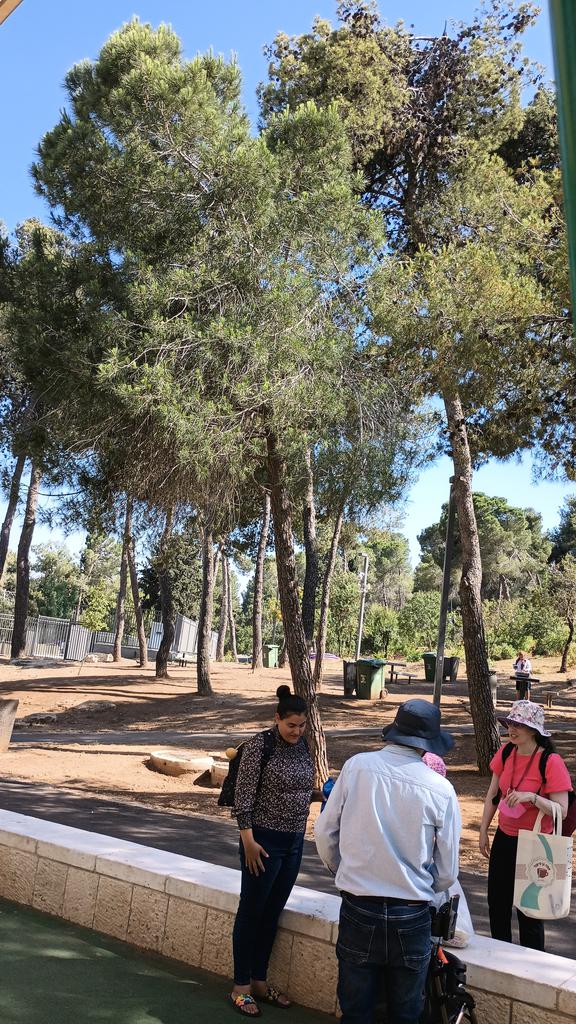
Context: This are "oranim", pine trees, specifically from Gan Sacher's playground in Jerusalem.
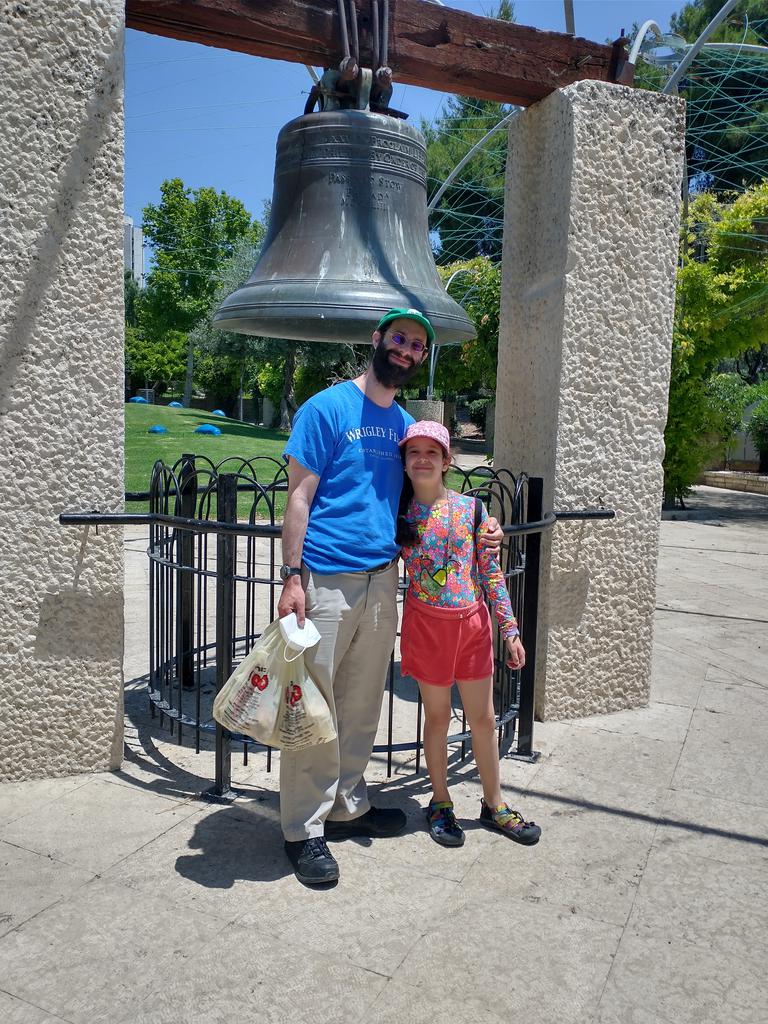
Context: This is the replica of the Liberty Bell in Gan HaPa'amon, "Liberty Bell Park". It is not the "pa'amonim" referred to in the song (those would be church bells), but it is the spot named for a "pa'amon". The park was dedicated in 1976 to celebrate the 200th anniversary of the United States of America. (https://israelbylocals.com/liberty-bell-park-jerusalem/).
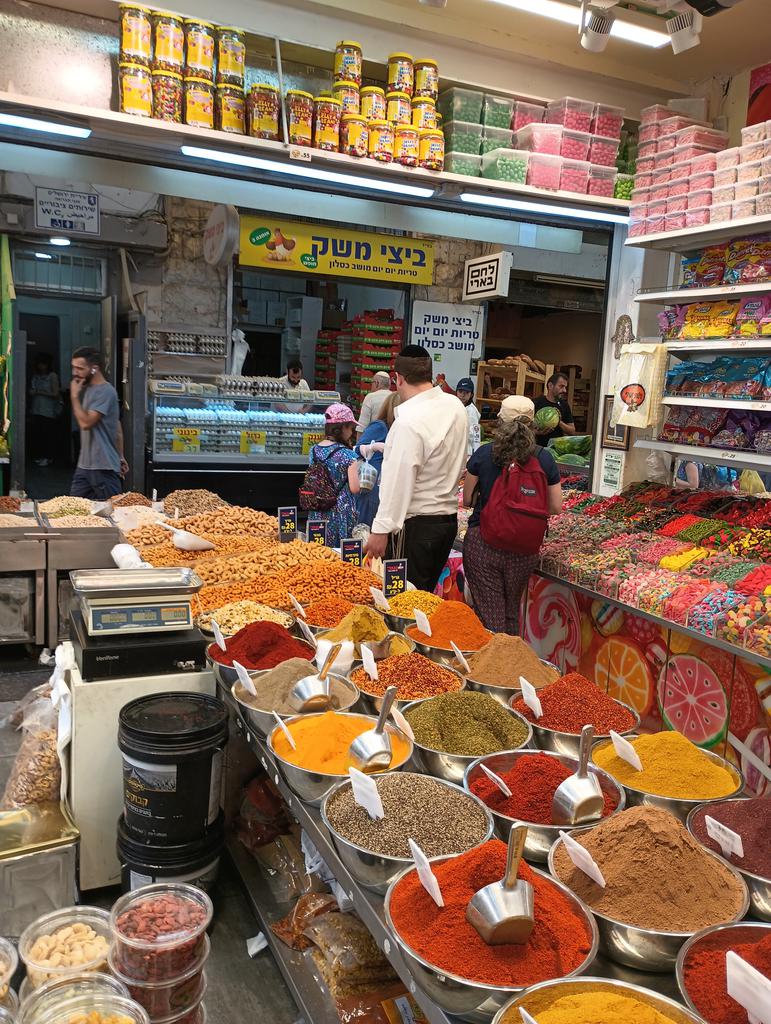
Context: This is the "shuk", the market, specifically Machaneh Yehudah Market.
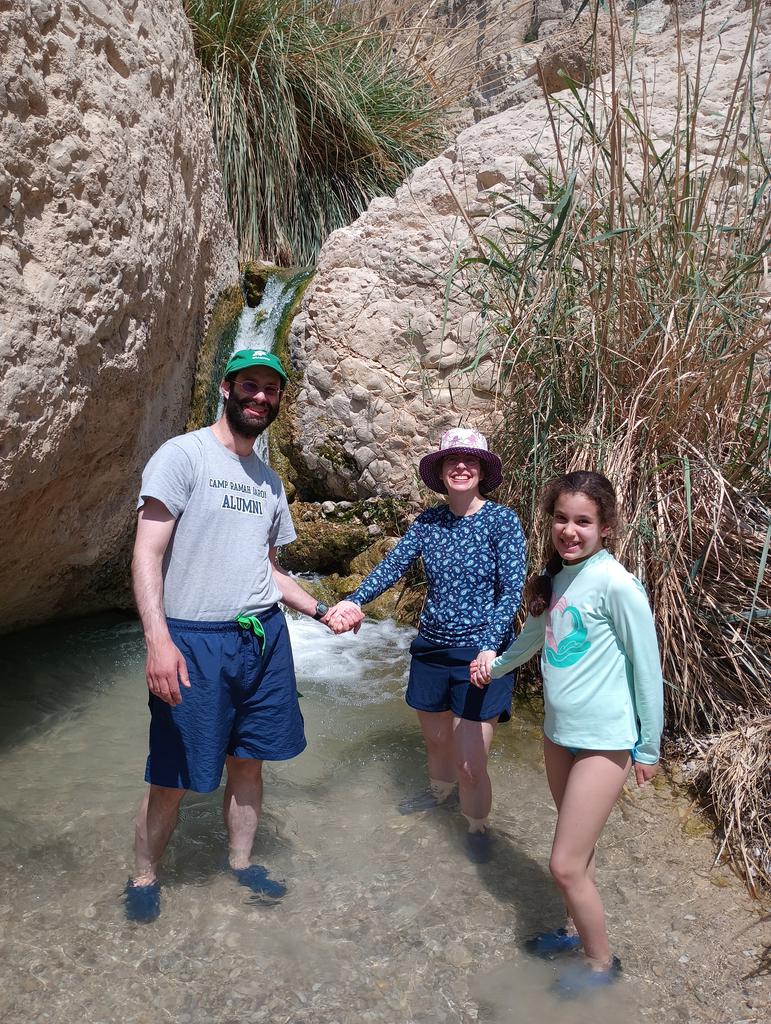
Context: There are "m'arot basela", caves in the rocks, at Ein Gedi, an oasis near the Dead Sea. Here is a "sela" (rock) from there.
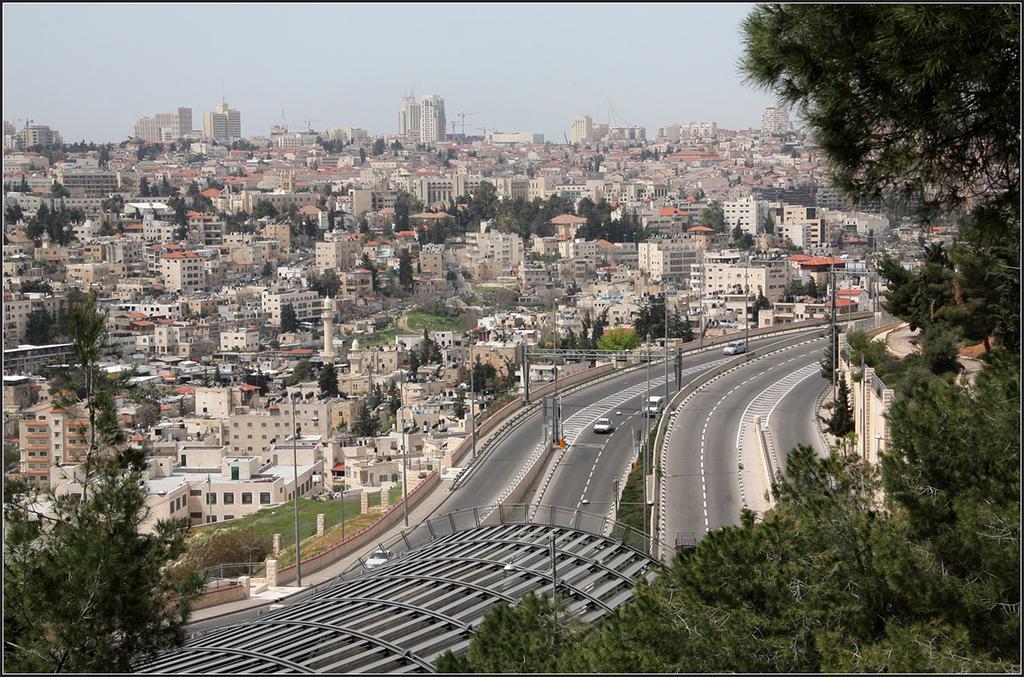
Context: In 2011, the Derech Har HaTsofim Tunnel off of Route 1 was renamed the Naomi Shemer Tunnel. This is because this is the tunnel that you take when you go to the Dead Sea ("shuv neilech el Yam HaMelach") from Jerusalem. (Picture: https://www.staedte-fotos.de/bild/israel-palaestina~jerusalem-bezirk~jerusalem/47136/-neue-schnellstrasse---diese-neue.html)
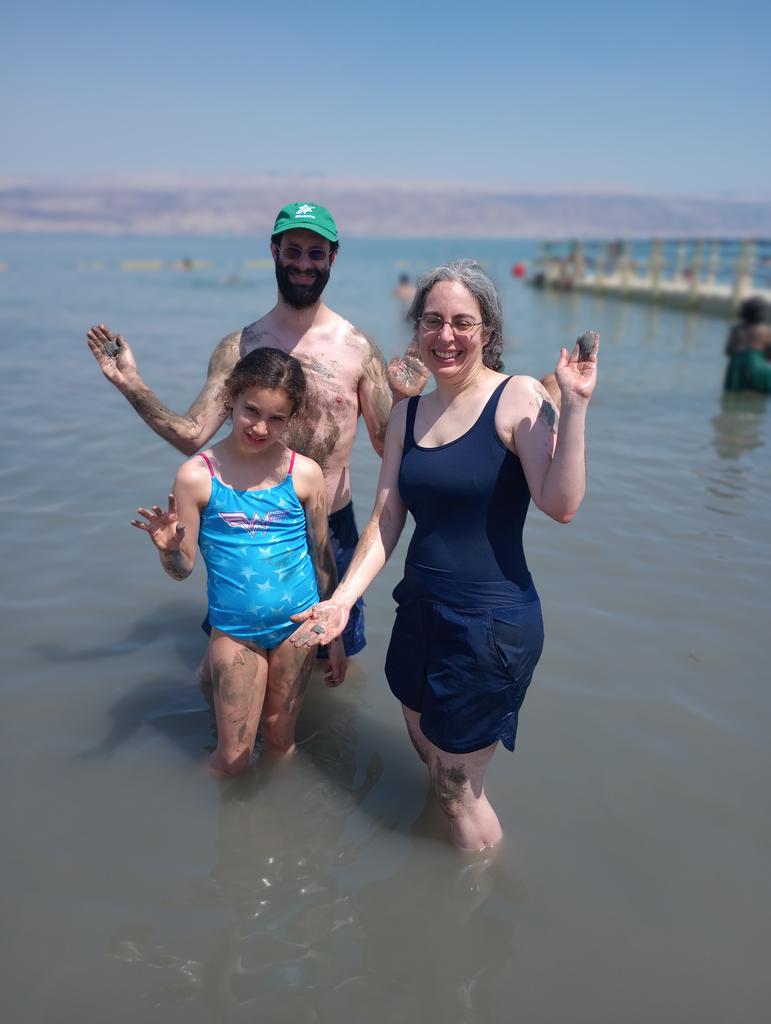
Context: This is "Yam HaMelach", the Dead Sea (literally, the Salt Sea). Here's a view from Neve Midbar Beach, on the northern end of the sea.
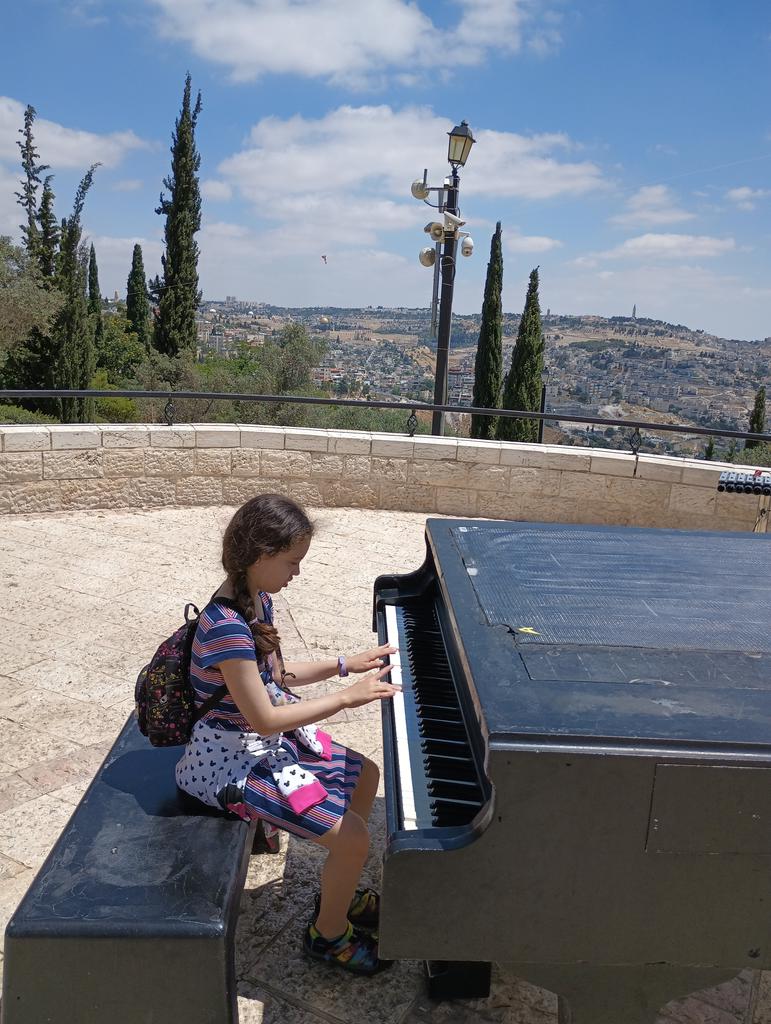
Context: This is from the Tayelet, a.k.a. Haas Promenade, a.k.a. Armon HaNatziv. If you go off to the side near the public bathrooms, there's a playground and also a public piano. Here we see the phrase "Ach b'vo'i hayom lashir lach" -- "I have come today to sing to you".

Context: This is one of the smallest of Jerusalem's children (3 months old), illustrating the phrase "katonti miTze'ir banayich".
Appendix B: A Contemporary Reflection on the Song
Jerusalem Stone
What comes to mind when visualizing the City of the Great King? Do you see images of the iconic stones of the Western Wall that have withstood centuries of conflict? Do you see the narrow streets of the Old City zigzagging through a maze of diverse cultures? Or perhaps you see the upscale Mamilla Mall, infused with the energy of high-end shopping and fine dining. No matter which images you envision, you will most assuredly see the ancient material that sets this city apart from all others: Jerusalem stone.
Built from Its Own Stones
I will never forget the first time I laid eyes on Jerusalem. As we drove into the city, the sea of buildings covered in white stone reflected the dazzling desert sun, casting an ineffable glow that left me speechless. Everywhere I looked I saw the same shade of stone, making it difficult for my untrained eye to tell the difference between something old and something new. Every structure I encountered in the city—from the Old City walls to the supermarkets on every corner—was faced with the same shade of luminous stone.
The appearance of Jerusalem’s architecture is uniquely uniform thanks to a municipal law enacted during the British Mandate that remains in effect to this day. This law requires that all structures in Jerusalem be faced in the same stone, preserving the archaic essence of the city and maintaining a legacy of stonework that has enabled so many ancient structures to survive.
Ever since its inception more than 3,000 years ago, Jerusalem has been built and rebuilt of its very own stone mined from deep beneath its hilltops, a practice that continues to provide the necessary stone for each new building raised in Jerusalem.
Ithamar Perath, a retired Israeli geologist and local Jerusalemite, explains that in ancient Jerusalem, it was a sign of wealth that the builders were not forced to transport materials from far away, but could rather quarry from their own backyard. And because much of this quarrying took place underground, it left very few lasting marks on the overall landscape. There are, however, several ancient quarries that have been unearthed in and around Jerusalem, including a quarry from the Second Temple Period that was exposed in the Ramat Shlomo Quarter, a neighborhood in northeast Jerusalem.
Yerushalayim Shel Zahav
Jerusalem stone has served to not only unify the appearance of the city but indeed the very heart of the nation. “Jerusalem of Gold” (Yerushalayim Shel Zahav)—one of Israel’s most beloved songs—was inspired by the golden glow cast by Jerusalem stone at sunset. And the song was written during one of the most critical moments in the history of the Jewish state.
The year was 1967. Jerusalem’s Old City remained under Jordanian occupation. As Israel approached its nineteenth Independence Day, the mayor of Jerusalem commissioned five songs about Jerusalem to be presented at the Voice of Israel Song Festival. Naomi Shemer, one of Israel’s most proficient songwriters, was more than qualified for the task. However, she struggled to adequately pen the profound importance of the city of Jerusalem. “Jerusalem was personal, beloved and important to me,” Shemer later recalled. “But when I tried to express this, I became terrified. I remembered everything that had been written about the city since ancient times…Who could add a single letter to that?!” The words that came were written through tears as she tenderly wove together biblical references and traditional Jewish poetry that was birthed in times of exile.
When “Jerusalem of Gold” debuted for the first time at the song festival, it was received with deafening applause and became a national favorite overnight, captivating the heart of the Jewish people as they yearned for access to their most beloved sites. Less than three weeks later, the Six Day War began. On June 7, Israel Defense Forces Paratroopers entered the Old City through the Lions’ Gate, advancing steadily towards the Temple Mount. Within mere minutes of penetrating the city, the radio cracked with the famous words of Commander Mordechai Gur: “The Temple Mount is in our hands.” As his battered troop of soldiers gazed upon the Western Wall for the first time, the words of Shemer’s song burst from their lips: “Oh, Jerusalem of gold, and of light and of bronze, I am the violin for all your songs.” I can only imagine the magnitude of that moment as these young soldiers gazed upon the ancient stones.
A Sure Foundation
In a city that has endured long and vicious cycles of destruction, siege, attack, capture and recapture, Jerusalem stone has firmly withstood the test of time, calling to mind the words of the prophet Isaiah: “Behold, I lay in Zion a stone for a foundation, a tried stone, a precious cornerstone, a sure foundation…” (Isa. 28:16) For me, this puts everything into perspective. No longer will I take for granted the need to shield my eyes from the glimmering glare of the sun reflecting off the Jerusalem stone all around me. Instead I will cherish every opportunity to bask in its glow and thank the Lord for His faithfulness to Zion.
- Sarah Yoder
https://www.bridgesforpeace.com/article/jerusalem-stone/ 4-28-21




